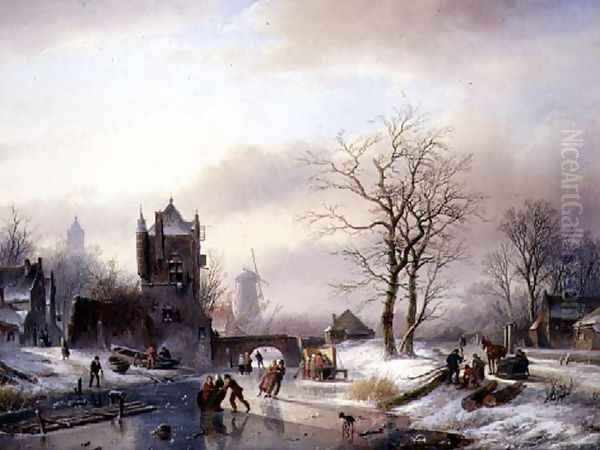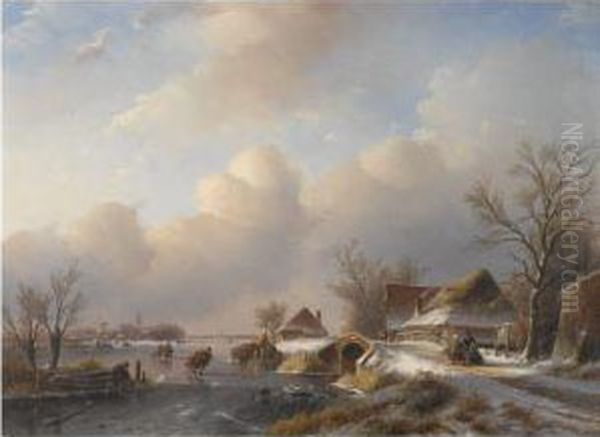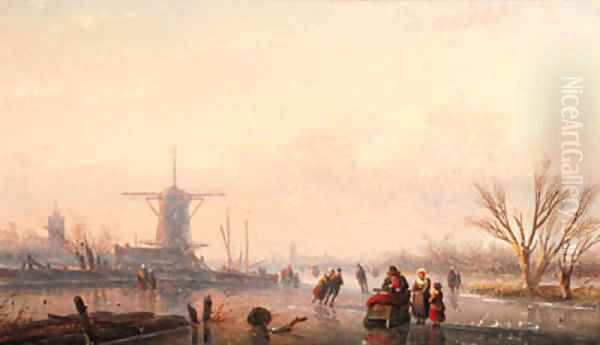Jan Jacob Spohler (1811-1866) stands as a significant figure in the rich tapestry of 19th-century Dutch art. Celebrated for his evocative winter landscapes, Spohler captured the quintessential spirit of the Netherlands during its colder months, a tradition deeply embedded in the nation's artistic heritage. His work is a testament to the enduring appeal of the Dutch Romantic movement, which sought to blend meticulous observation with a profound appreciation for nature's atmospheric beauty. This article delves into the life, work, and legacy of this accomplished painter, placing him within the broader context of European art history.
Early Life and Artistic Awakening
Born on November 7, 1811, in Nederhorst den Berg, a small town near Amsterdam, Jan Jacob Spohler was immersed from a young age in the picturesque landscapes that would later define his oeuvre. The Netherlands, with its intricate network of canals, expansive skies, and charming villages, provided an inexhaustible source of inspiration for artists. Spohler's formative years coincided with a period of renewed national pride and a burgeoning interest in depicting the local environment, a departure from the more grandiose historical or mythological themes that had dominated earlier academic art.
His formal artistic training began under the tutelage of Jan Willem Pieneman (1779-1853), a highly respected figure in Dutch art circles. Pieneman was renowned for his historical paintings, including the monumental "The Battle of Waterloo," and portraits. As a professor and later director of the Royal Academy of Fine Arts (Koninklijke Akademie van Beeldende Kunsten) in Amsterdam, Pieneman's influence extended to a generation of Dutch artists. Under his guidance, Spohler would have honed his technical skills in drawing, composition, and the use of color, laying a solid foundation for his future career.
The Royal Academy and Early Career

Spohler's talent was recognized early on, and he became a member of the prestigious Koninklijke Akademie van Beeldende Kunsten in Amsterdam in 1845. Membership in such an institution was a significant acknowledgment of an artist's skill and standing within the artistic community. It provided opportunities for exhibition, networking with fellow artists, and access to further learning. During this period, Spohler began to specialize in landscape painting, with a particular affinity for winter scenes, a genre that had a long and storied history in Dutch art, harking back to the Golden Age masters of the 17th century.
His early career saw him active in Amsterdam, but like many artists of his time, Spohler was somewhat peripatetic. He worked and exhibited in various Dutch and Belgian cities, absorbing diverse influences and showcasing his developing style. Records indicate his presence and exhibitions in Haarlem, a city with its own rich artistic traditions, and Brussels between 1844 and 1845. He later spent time in The Hague (1848-1849), Leiden (1850-1854), and Rotterdam (1854-1855), before eventually settling back in Amsterdam, where he would spend the remainder of his life.
The Dutch Romantic Tradition
To fully appreciate Jan Jacob Spohler's contribution, it is essential to understand the Dutch Romantic movement within which he worked. Romanticism in the Netherlands, while sharing some characteristics with its counterparts in Germany, Britain, and France, possessed a distinctly local flavor. It was less about dramatic, sublime wilderness and more focused on the intimate, often domesticated, beauty of the Dutch countryside. There was a nostalgic element, a longing for the perceived tranquility and picturesque charm of earlier times, particularly the celebrated 17th-century Dutch Golden Age.
Artists of this era sought to capture the unique atmospheric conditions of the Low Countries – the soft, diffused light, the dramatic cloud formations, and the subtle interplay of water and land. Key figures in Dutch Romantic landscape painting include Barend Cornelis Koekkoek (1803-1862), often hailed as the "Prince of Landscape Painters," whose meticulously detailed summer and winter scenes set a high standard. Andreas Schelfhout (1787-1870) was another towering figure, particularly renowned for his winter landscapes, and his influence on Spohler is palpable. Other contemporaries like Charles Leickert (1816-1907), who also specialized in atmospheric winter scenes and townscapes, and Cornelis Springer (1817-1891), famous for his detailed city views, further defined this period.
Spohler's Signature: The Winter Landscape

Jan Jacob Spohler carved a distinct niche for himself with his masterful depictions of winter. His canvases are often populated with figures engaged in typically Dutch winter activities: skaters gliding gracefully or energetically across frozen canals and rivers, children playing, and villagers going about their daily chores against a backdrop of snow-covered cottages, windmills, and bare-branched trees. These scenes were not merely topographical records but were imbued with a sense of lively charm and nostalgic sentiment.
His paintings, such as the archetypal "Skaters on a Frozen River" or "Winter Landscape with Figures on the Ice near a Windmill," showcase his skill in rendering the crisp, cold air, the reflective qualities of ice, and the subtle gradations of winter light. Spohler paid meticulous attention to detail, from the textures of clothing and the rendering of bare branches to the architectural features of nearby buildings. His brushwork, while precise, often retained a softness that contributed to the overall romantic atmosphere of his works. He masterfully used a palette that, while dominated by cool blues, whites, and greys, often incorporated warmer tones in the figures or architectural elements to create visual interest and focal points.
Another notable work, often titled along the lines of "Fishermen on the Canal in Winter," would typically depict a serene, ice-bound waterway. Here, Spohler would focus on the quiet industry of figures braving the cold, perhaps tending to nets or conversing near a small fire. The compositions are generally well-balanced, often employing a diagonal recession into space, drawing the viewer's eye through the scene. The sky, a dominant feature in Dutch landscape painting, is rendered with sensitivity, conveying the specific mood of a winter's day, whether it be overcast and still or bright and crisp.
Artistic Techniques and Stylistic Elements
Spohler's style is characterized by a harmonious blend of detailed realism and romantic sensibility. He was adept at capturing the play of light on snow and ice, creating a sense of depth and atmosphere. His figures, though often small in scale relative to the landscape, are rendered with care and contribute to the narrative and human interest of the scene. They are not mere staffage but integral parts of the composition, animating the landscape and providing a sense of scale and everyday life.

His compositions often feature a low horizon line, a characteristic of much Dutch landscape painting, which allows for an expansive depiction of the sky. This emphasis on the sky contributes significantly to the mood of his paintings. The trees in his winter scenes are particularly noteworthy, their bare branches intricately delineated against the sky, creating delicate, lace-like patterns. Windmills, iconic symbols of the Dutch landscape, frequently appear in his works, adding a picturesque and culturally specific element.
Compared to some of his contemporaries, Spohler's work often possesses a slightly more idyllic and less dramatic quality. While Andreas Schelfhout, for instance, could imbue his winter scenes with a sense of grandeur or even harshness, Spohler's interpretations tend towards a gentler, more charming portrayal of winter life. His paintings evoke a sense of community and the simple pleasures of life, even amidst the cold.
The Influence of the Dutch Golden Age
The 19th-century Dutch Romantics, including Spohler, were deeply indebted to their 17th-century predecessors. The Golden Age of Dutch painting had established landscape, particularly winter scenes, as a significant and popular genre. Artists like Hendrick Avercamp (1585-1634), with his lively and detailed ice-skating scenes, and Aert van der Neer (1603-1677), known for his moonlit and winter landscapes, had set a precedent. Jacob van Ruisdael (c. 1629-1682) and Jan van Goyen (1596-1656) also contributed significantly to the development of landscape painting, capturing the Dutch environment with remarkable naturalism and atmospheric depth.
Spohler and his contemporaries consciously looked back to this golden era, drawing inspiration from its themes, compositional strategies, and meticulous attention to detail. The enduring popularity of these subjects with the Dutch public also played a role, as collectors sought works that resonated with their national identity and cultural heritage. Spohler’s ability to tap into this tradition, while infusing it with the sensibilities of his own time, was key to his success.
A Teacher and His Artistic Progeny
Beyond his own prolific output, Jan Jacob Spohler also contributed to the continuation of Dutch artistic traditions through teaching. He passed on his knowledge and skills to his sons, who themselves became recognized painters. Jan Jacob Coenraad Spohler (1837-1923), often known as J.J.C. Spohler, followed closely in his father's footsteps, also specializing in landscapes, particularly summer scenes and views with windmills, though he did paint winter scenes as well. His style often mirrors his father's meticulous detail and romantic atmosphere.
Another son, Johannes Franciscus Spohler (1853-1894), also became a painter, though he is perhaps less widely known than his father or brother. The family's artistic lineage demonstrates the common practice of artistic skills being passed down through generations. Spohler is also recorded as having taught Willem Vester (1824-1895), a painter known for his landscapes and cattle scenes, further extending his influence. This role as an educator underscores Spohler's commitment to the craft and his part in nurturing the next generation of artists.
Travels, Exhibitions, and Recognition
Spohler's career was marked by consistent activity and participation in the art world of his time. His decision to work in various cities like Haarlem, Brussels, The Hague, Leiden, and Rotterdam indicates an artist keen to engage with different artistic environments and markets. Exhibiting his works in these locations, as well as in Amsterdam, was crucial for establishing his reputation and securing patronage.
The 19th century saw a growth in public exhibitions and art societies, providing artists with platforms to display and sell their work. Spohler's participation in these exhibitions would have brought his art to the attention of a wider audience, including private collectors and public institutions. While detailed records of all his exhibitions are not readily available, his membership in the Royal Academy and his active career across several cities suggest a well-regarded professional. His paintings found their way into numerous private collections during his lifetime and continue to be sought after by collectors of 19th-century Dutch art.
Contextualizing Spohler with Other European Romantics
While Spohler was firmly rooted in the Dutch tradition, it's useful to briefly consider him in the wider European Romantic context. In Germany, artists like Caspar David Friedrich (1774-1840) explored themes of sublime nature and spiritual introspection, often with a more melancholic or overtly symbolic tone. British Romanticism saw giants like J.M.W. Turner (1775-1851), with his dramatic and atmospheric seascapes and landscapes, and John Constable (1776-1837), whose detailed studies of the English countryside emphasized naturalism.
The Dutch approach, as exemplified by Spohler, was generally less overtly dramatic or philosophical. It was more grounded in the observable world, celebrating the specific character of the local landscape and the everyday lives of its inhabitants. This is not to say it lacked emotional depth, but its romanticism was often expressed through a quieter, more intimate appreciation of nature and a nostalgic fondness for traditional ways of life.
Later Career and Enduring Legacy
Jan Jacob Spohler continued to paint and remain active in Amsterdam until his death. The most consistently cited date for his passing is December 17, 1866, in Amsterdam, at the age of 55. It is important to note that some historical sources present conflicting information regarding his death date, with some mentioning 1894 or even 1923. These discrepancies likely arise from confusion with his son, Jan Jacob Coenraad Spohler (who died in 1923), or perhaps other similarly named individuals, a common issue in art historical records before meticulous modern documentation. However, the 1866 date is the most widely accepted by art historical consensus for Jan Jacob Spohler senior.
His legacy is primarily that of a skilled and dedicated painter of Dutch winter landscapes. His works are appreciated for their technical proficiency, charming subject matter, and their embodiment of the Dutch Romantic spirit. Paintings by Jan Jacob Spohler can be found in various museum collections, including the Teylers Museum in Haarlem and formerly noted in connection with the Stedelijk Museum in Amsterdam, though works of his period are more typically found in the Rijksmuseum or the Amsterdam Museum today, as well as in numerous private collections worldwide. His art continues to appeal to those who appreciate traditional landscape painting and the unique charm of Dutch winter scenes.
The enduring popularity of his work is also evident in the art market, where his paintings regularly appear at auction and command respectable prices. This speaks to a sustained appreciation for his ability to capture a specific and beloved aspect of Dutch culture and landscape.
Conclusion: The Enduring Charm of Spohler's Winter
Jan Jacob Spohler was a master of his chosen genre. He skillfully combined the meticulous observation inherited from the Dutch Golden Age with the romantic sensibilities of the 19th century. His winter landscapes are more than just picturesque views; they are windows into a world of bustling activity, quiet beauty, and the enduring human spirit in the face of nature's colder moods. He captured the crisp air, the glistening ice, and the cozy warmth of village life with a deft hand and a keen eye for detail.
While perhaps not as revolutionary as some of his European contemporaries, Spohler's contribution to Dutch art is significant. He, along with artists like Schelfhout, Koekkoek, and Leickert, helped to sustain and reinvigorate the tradition of landscape painting in the Netherlands, creating works that resonated deeply with national sentiment and continue to delight viewers today. His paintings serve as a charming and enduring record of Dutch life and landscape in the 19th century, securing his place as a beloved painter of winter's embrace. His influence, seen through his students and sons, also highlights his role in the continuity of artistic traditions in the Netherlands. Jan Jacob Spohler remains a respected and cherished figure in the narrative of Dutch art history.